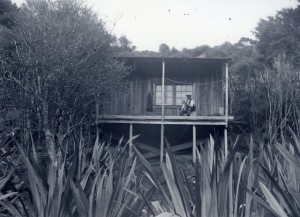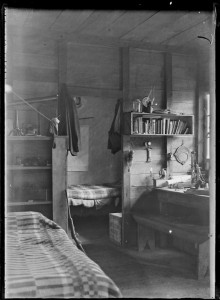In 2008 I was contacted by Robin Skinner, Senior Lecturer in Architecture at Victoria University, to ask about a photo I had used in my book Piha: A History in Images, published in 1997.
Little did I know that the image of Hans Peter Knutzen, manager of the Piha Mill, photographed sitting on the front veranda of his mill house has been used as an icon of New Zealand architecture for over 50 years. But the interpretation of the photo, lacking its history and context, had led people to jump to all sorts of completely erroneous conclusions about the man and his surroundings.
The photo shows Knutzen reading a book on the front verandah of a simple board-and-batten bach surrounded by kanuka and flax.
In 1954 the image was found among a box of uncatalogued glass plates at the Alexander Turnbull Library by people assembling an important exhibition curated by the Auckland University School of Architecture for the Auckland City Art Gallery ” Home Building 1814-1954 the New Zealand Tradition. In the exhibition, the image was labelled ˜Bach in King Country ” Simplicity, Honesty, realism’ and was seen as representing the origins of the modernist style and the beginning of an authentic New Zealand domestic architectural vernacular.
After the exhibition an enormous copy of the photo was hung in the Auckland School of Architecture, influencing decades of budding student architects.
The image has been widely referenced and used as a kind of heroic ˜man-alone’ icon ” in one television programme dubbed as ˜Adam’s other house in paradise?’
Robin Skinner tells me there was a degree of consternation when my book appeared with the image correctly labelled and the location identified as Piha. Mr Knutzen was not sitting alone in a bush wilderness, but was overlooking a huge noisy industrial enterprise. In front of him were the stacking yards of the Piha Mill, with the engine A196 plying too and fro pulling logs, and steam belching from the mill boilers. Using the original photos, I have been able to locate the approximate site of his house opposite the bridge to Stedfast Park, on the southern side of Glen Esk Road.
His house did not have a modernist flat roof which was assumed from the photo. That was a product of the angle of the photographer, and another photo of the bach in the same series by AP Godber show a conventional pitched roof.
What’s more, Mr Knutzen was a man of some substance and all photographs of him at Piha show him displaying his status by always wearing a waistcoat or jacket and tie, and usually a brimmed hat. He was born in Felstead, Denmark. He jumped ship in New Zealand in 1883, worked on boats around the New Zealand coast, spent seven years digging gum and as a bushman, and gained his mine manager’s ticket at the Thames School of Mines. He began his association with Dr Rayner in 1907 when he managed his Taumaranui Totara Timber Company Mill and in 1912 was brought in to manage the Piha Mill which had got into some financial difficulty while Rayner was in America. Knutzen worked closely with Dr Rayner all his life.
He was certainly not ˜man-alone’. In 1890 he had married Rose Grey in Whangarei and the couple had 10 children. Distressingly, only two of these children lived. The others seem to have died from TB. While Mr Knutzen lived in the bach at Piha, Rose lived in quite substantial villas that are now very desirable real estate in John Street and then Rose Road, Ponsonby. He owned a large block of land at Whatipu and ran in and out of Piha in a large Ford motor vehicle.
At Piha, Knutzen did not ˜bach’ but had a housekeeper to keep his living space neat and tidy. Robin Skinner and I think we have identified the interior of his bach as a photo previously labelled by the Turnbull Library as a gumbleeders’ quarters. But no gumbleeders lived with tidy bedspreads on the beds, books on shelves or the esoteric scientific equipment shown in the bach interior, and having recently gone back to the albums in the Turnbull, it seems that this description has been added by cataloguers rather than the original photographer.
In 1923 Rose Knutzen had a stroke which paralysed her, and Minnie Bowdler, the estranged wife of one of the bushmen at the Mill, was employed to nurse her. You will see her husband Vincent Bowdler’s name on the Roll of Honour on Lion Rock.
Following the death of his wife in 1939, Mr Knutzen served divorce papers on Vincent Bowdler, by now working in Rotorua, and married Minnie.
After the Piha Mill closed down Mr Knutzen managed mill operations at Ohakune then the Mamakus and some of the Piha mill workers followed him there. The mill manager was a pivotal person in the operation of any mill and the mill workers spoke highly of his skills and kindness.
Knutzen died in 1945. I am sure if he could come back, he would be amazed to know his little bach at Piha had entered into the annals of New Zealand architecture and become so famous and influential.
Here is Robin Skinner’s paper skinner_published




